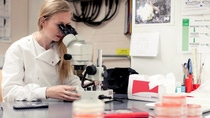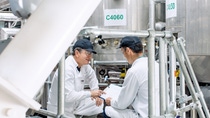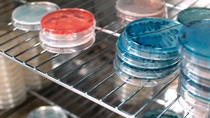Core Topics
Using nature to protect plants

Biopesticides offer a way of using nature against itself. We take a look inside a BASF production site that breeds nematodes – tiny worms that can be used in plant protection to control a wide variety of pests.

It’s not often you get to look inside a huge tank filled with eight trillion tiny worms. The worms in question are beneficial nematodes, bred in one of BASF’s crop protection sites to be sold as a biological pesticide. Nematodes are ideal for plant protection. They actively seek pests like slugs, weevils or caterpillars, invade and devour them. The site has been located in Littlehampton on the English south coast for more than 30 years and is now the largest nematode production facility in the world.
Site manager Mark Downing oversees a team of 35 employees. “We’re not out to replace chemical pesticides, there is a need in the market for both,” he says. “But with increasing demand for organic production and tougher regulations, we are getting a foothold.” Downing is joined by fermentation manager Tom Goddard and formulating and packaging scientist Sarah James, PhD, to give us a tour of the factory floor.
The first room is filled with shiny cylindrical tanks and a bewildering array of pipes that snake their way around the site. The process starts by passing nematodes through an insect. “This is to prove their efficacy,” explains Goddard. Only the nematodes that kill the host insect are used. They are transferred to a flask, where they are encouraged to feed on nutrients and then used to seed smaller tanks. The process is scaled up in ever larger vessels until the nematodes have multiplied from a few thousand to trillions. The nematode lifecycle has five stages. Those that go on the market are the infective juveniles – the only stage where they can survive outside a host. Currently the facility produces six different species of nematodes to target different kinds of pests. Some are ideal for managing fungus gnats, root flies and western flower thrips in horticulture and vegetable production. Others provide control of slugs, codling moths and red palm weevils. BASF works with local and international researchers to discover new, potentially useful species.
Nematodes are ideal for plant protection. They actively seek pests like slugs, weevils or caterpillars, invade and devour them.

In the middle of the production facility stands “El Gordo,” Spanish for “the fat one.” A 102,000-liter vessel, about 12 meters high, it is used to brew the Steinernema feltiae species, which is marketed under the brand name Nemasys®. “That’s our biggest selling product,” says Goddard. “We sell trillions of these nematodes a year.”
Once brewed to the right stage, the nematodes are mixed with a special formulation and packed into what look like microwave dinner trays. Goddard shows two packs containing over 1.5 billion nematodes which are destined for Florida, to help tackle pests that are threatening orange groves. “This will cover something like 15 acres, or around nine soccer pitches. It’s diluted in a tank with water, then sprayed on the crop,” he says.
James works in the formulating and packaging lab finding ways to overcome problems like overheating. The heat comes from the nematodes’ metabolism as they feed. With the tanks containing up to 200,000 nematodes per milliliter, this is a serious concern. She shows three containers of new formulations she has mixed as an experiment to find out what will improve the shelf life of a living product. James joined BASF as she was finishing her PhD. “I was studying ways of using nature against itself. I like the idea of using a natural predator to target what we consider pests,” she says. The Nemasys product typically kills 60 to 80 percent of the pests on plants.
“The market for nematodes started small but is growing every year,” says Downing. “We like to think we’re providing the technology of the future.”









